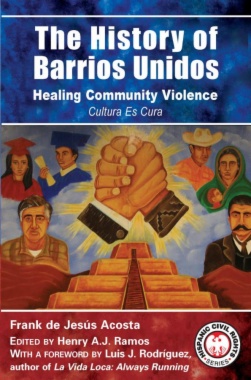This is the compelling story of Barrios Unidos, the Santa Cruz-based organization founded to prevent gang violence amongst inner-city ethnic youth. An evolving grass-roots organization that grew out of the Mexican-American civil rights and anti-war movements of the 1960s and 1970s, Barrios Unidos harnessed the power of culture and spirituality to rescue at-risk young people, provide avenues to quell gang warfare, and offer a promising model for building healthy and vibrant multicultural communities.
Co-founder Daniel Nane Alejándrez spent his childhood following the crops from state to state with his family. His earliest recollection of home was a tent in a labor camp. Later, he was drafted in to the Army and sent to Vietnam. Flying bullets, cries of anguish and being surrounded by death have a way of giving fuel to epiphany. This war made as little sense to me as the war raging on the streets of the barrios back home. He decided that when he returned home, he would dedicate himself to peace. Nane Alejándrezs story of personal transformation, from heroin-addicted gang banger to social activist and youth advocate, is closely tied to that of Barrios Unidos.
- Cover
- Title page
- Copyright page
- Dedication
- Contents
- Editor’s Note by Henry A.J. Ramos
- Foreword by Luis J. Rodríguez. Yocoxcayotl: The Movement for Peace and Healing Through Barrios Unidos
- Author’s Note and Acknowledgments
- Introduction. The Power of Culture and Spirituality: Cultura es cura
- The BU movement: history and early influences
- Building an organization, sustaining a movement
- Content of the book
- Part I Barrios Unidos: The Formative Years
- Introduction
- The historical context
- Sociological factors
- The founding circle of BU: Peace warriors
- Daniel "Nane" Alejándrez, Barrios Unidos Founder
- Organizing in the early days
- Organizational partners and influences: forging the BU vision
- Coalition to end Barrio Warfare
- Arts and culture
- The civil rights movement and spirituality
- D-Q university and the connection to native groups
- Henry Domínguez, BU elder and spiritual leader
- The late 1980s: solidigying the base and establishing new partnerships
- Big mountain, Arizona: the resistance movement
- Future planning and establishing an organizational culture
- Walter Guzmán (1954-2000), 1st board president
- Otilio "OT" Quintero, Co-arquitecto of the BU community organization
- Responding to crisis, formalizing a structure, broadening the leadership corps
- Taking Stock, reflecting on BU's legacy
- Part II Building an Organization, Sustaining a Movement
- Introduction
- Broader sociopolitical context (1990-1993)
- Gathering the founders
- Bu's guiding vision, values, and principles
- Part III The Barrios Unidos Theory of Change and Strategies in Action
- A Living Theory of Change
- Healing and transformation: reclaiming and restoring community culture
- Creating a sacred place: the Santa Cruz BU Center
- Rituals and practices to strenghten cultural and spiritual foundations
- La cultura es cura: Curriculum and other education programs
- The César Chávez school for social change
- Developing the core curriculum-Albino García, Sr
- The rites of passage program
- The challenges of implementing BU's core curriculum
- The power of results
- Growing Leaders through Chapter Building
- Peace Summits: Connecting and Organizing Multicultural Leaders
- The César Chávez Peace plan
- National movement-building: interethnic partnerships and intercultural exchange
- The Kansas city peace summit
- The Simba circle (Rescue, release and restore, inc. )
- Promoting Community Self-Reliance and Self-Sufficiency
- Barrios Unidos as a Catalyst for social enterprise
- Formative steps in community economic development
- The Barrio Enterprise Zone (BEZ)
- Moving into the Future: The Barrios Unidos Institute
- Summing Up and Looking Ahead
- Santa Cruz Barrios Unidos strategies
- Santa Cruz Barrios Unidos core program summaries
- Part IV Essential Voices on Civil Rights and Community Peace
- Introduction
- Dolores Huerta
- Nonviolence and social change
- Spiritual and cultural center of the movement
- Important lessons, accomplishments, and unfinished business
- Today's priorities for reviving the movement
- Harry Belafonte
- Nonviolence and social change
- Important lessons and unfinished business
- Getting the movement back on track
- Other civil rights priorities
- The Barrios Unidos Movement
- Closing Thoughts
- Tom Hayden
- Lessons of the civil rights movement
- Advancements in rights, race, and privilege in multicultural America
- Priorities for contemporary civil rights
- Advancing the community peace movement
- Conclusions
- Constance “Connie” Rice
- Nonviolence and the community peace movement
- The state of civil rights
- The community peace movement - Ground zero
- The priority for civil rights
- Reviving the movement
- Manuel Pastor
- Lessons and accomplishments of civil rights
- Advancing the agenda of civil rights - Combing research and activism
- Contemporary fronts - Expanding our view of civil rights
- The role of Barrios Unidos and the Community Peace Movement
- Conclusions
- Part V Author’s Observations, Conclusions, and Thoughts About the Future
- Sustaining the Movement
- Santa Cruz Barrios Unidos: looking back, looking forward
- Managing growth and sustainability: lessons learned, emerging imperatives
- Founding and resource development
- The reorganization: achieving maturity as a nonprofit
- Sustainability
- The Barrios Unidos Enterprise Zone and The César Chávez Peace Plan
- Advancing the Community Peace Movement
- Developing New Movement Leaders
- Community capacity-building and support - Local chapters
- Setting a political agenda based on core social objectives
- Criminal and juvenile justice reform
- Expanding models in community support, education, and public-private partnership
- Prison interventions: the Barrios Unidos Prison Project
- Increasing investment in violence prevention
- Advancing community peace and civil rights: what now?
- Achieving True American democracy: truth and reconciliation
- Conclusion
- Appendix. Selected poems: Palabras de amor, justicia y paz

